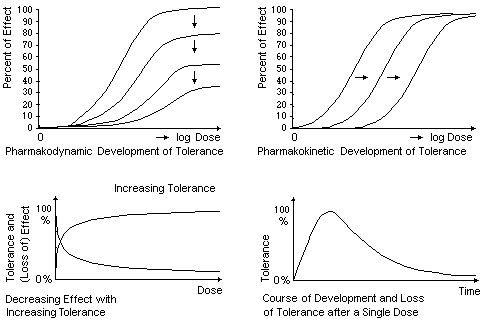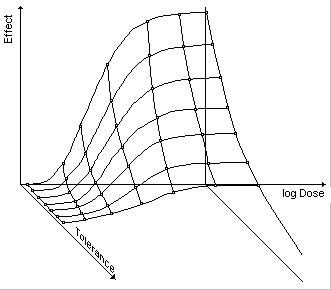

Abb.19: Tolerance (Getting Used to, Decrease in Effect)
The effect of a certain substance can change through repetitive or constant influx of a certain substance / medicine / drug. This process is called Adaptation. If the effect of a certain dosage increases, by adaptation, it is called Sensitisation. The overall decrease in effect after repeated consumption or constant influx of a substance is called Tolerance (see Abb.19). The same dosage does not have the same effect in life forms which have a certain tolerance; the dose must be increased in order for the same effect to be reached. The development of tolerance can develop overall differently and with varying chronological effects. The S-shape dosage-effect curve moves to the right with higher dosages (decreased potency) or the maximum effect (Efficacy) becomes less.

Fig.20: Pharmakodynamic Tolerance:
As the actual tolerance increases, the less the effect is of the next dose
The so-called tolerance, through habitation, occurs in two ways in the body:
Tab.11: Different Tolerance against Effects of Opioids
Pronounced |
Middle |
slight |
| Analgesic Euphoria Sedation
Dysphoria Antidiuretic |
Breathing Depression
Nausea (immediate Antitussive effect Bradykardia |
Miosis Constipation
Menstrual cycle Blocking effect of Antagonists |
The opioid Methadone effects is decreased through two tolerance-forming mechanisms: through the Enzyme induction forms the pharmacokinetical tolerance and the pharmacodynamical through the reduction of the presynaptic opioid receptors. Enzyme induction through barbiturates, Antiepileptica and – especially clinically and quantitatively relevant – throughTuberculostatica (INH) is the metabolism of methadone accelerated through Enzyme induction. Methadone is subject to an intensified pharmacokinetic Tolerance forming mechanism during Tuberculosis treatment (see chapters 21 & 26.1).
Addicts usually consume opioids in doses which would be fatal for people who are not used to it and are intolerant. Tolerance means that one can bear higher doses and serum concentrations.
A habit is noticeable just after a few days of constant opioid consumption. Sadly, there is no quantitative data about the chronological course of tolerance development in people. (see Chapter 11)
Tolerance develops with the Opioid – receptors and is substance specific (Koob 1992). The constant flux of opioids causes Cross tolerance against the effects of the other Opioid agonists.
As the affinity of a substance to it’s receptor increases and as the relative intrinsic activity becomes larger, so does the extent and speed pharmacodynamic Tolerance formation increase. Opioid-tolerance develops visibly in relation to pain inhibition, euphoria and central numbing; empirically, it seems that this development takes a parallel course chronologically and quantitatively. The paralysis of the respiratory centre under lies a slightly less obvious tolerance development. The effects on the smooth muscle, the formation of disturbances in the cycles and the formation of pin-pupils are observed in drug-dependent people, whether it is heroin, morphine or methadone even when it is habitual, i.e. these effects show a substansibly less tolerance development
Case 1: Opioid tolerance due to repetitive or chronic intake of opioid doses is made up of many varied, single Adaptation processes in the different neuronal and neurochemical systems. (Nestler 1994, 1996, Smart 1996, Kuhar 1996, Nutt 1996). The Expression of different proteins and peptides is changed and the number of receptors is drastically decreased (down-regulation). Surprisingly, b-Endorphine concentrations in the brain (compensating?) are raised through short term administering of the opioid agonists Morphine, Heroin or Methadone and on the other hand, decreased through the antagonists, Naloxon or during opioid abstinence (Kosten 1992). The b-Endorphin mirror in the brain normalises under constant effect of methadone through chronic administering; on the other hand, the b-Endorphine concentrations, under chronic treatment with Naltrexon, stay constantly high.
Opioids influence the ability to pay attention for simple and complex stimuli / tasks (Gordon 1970, 1994). The level of endorphine is crucial (Rosenberg 1994). Naltrexon decreases the area of attentivity for few key-stimuli (Arnsten 1981). Exogenic opioid consumption disables the effect of endogenic peptides by competing for the opioid receptors which are in a tolerant state. The large restriction in the range of feelings is also, along with the restriction in attentivity, a possible consequence of Adaptation due to opioid consumption: the euphoric highs as well as the feelings of uneasiness and sensitivity are numbed.
On the basis of neurochemical results after abstinence from nicotine, cocaine but also from opioids, are irreversible Adaptations mechanisms suspected (Dani 1996, Kuhar 1996, Smart 1996). The question of whether this is due to falling back into the addiction is still open.